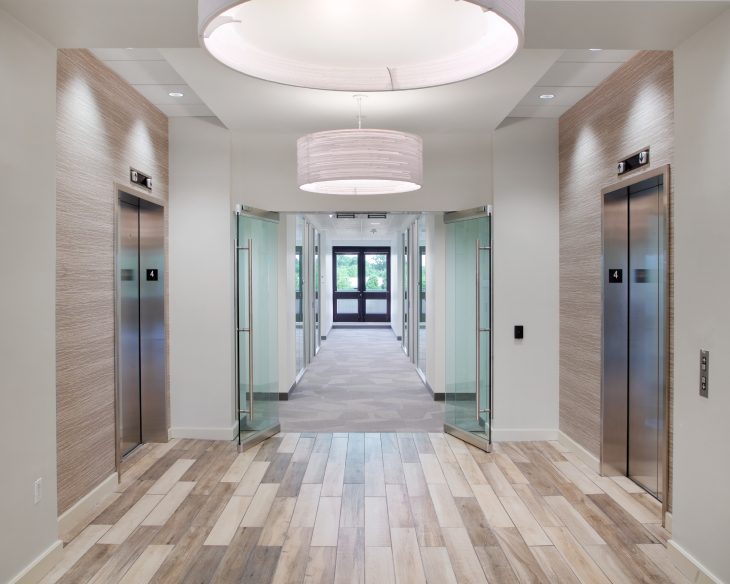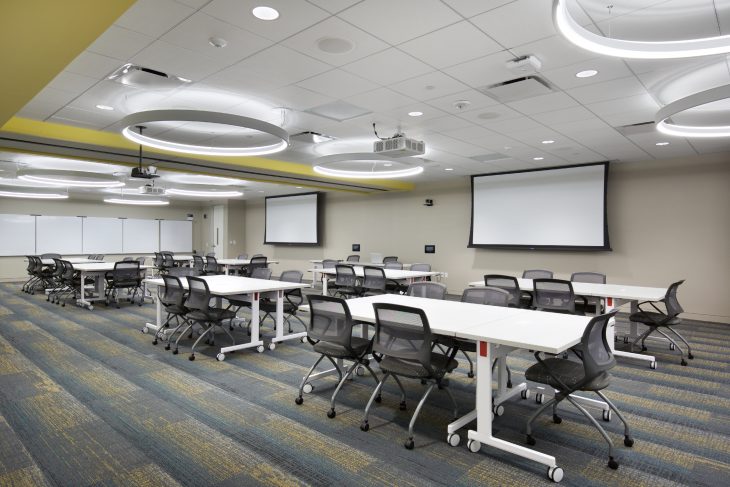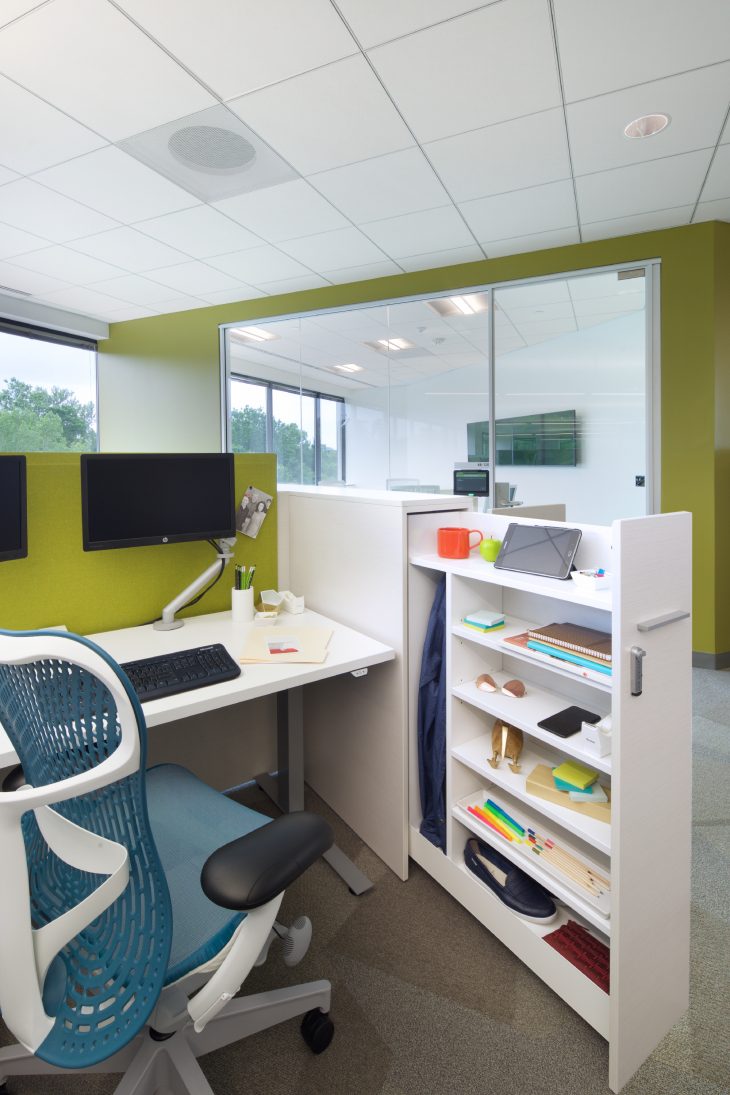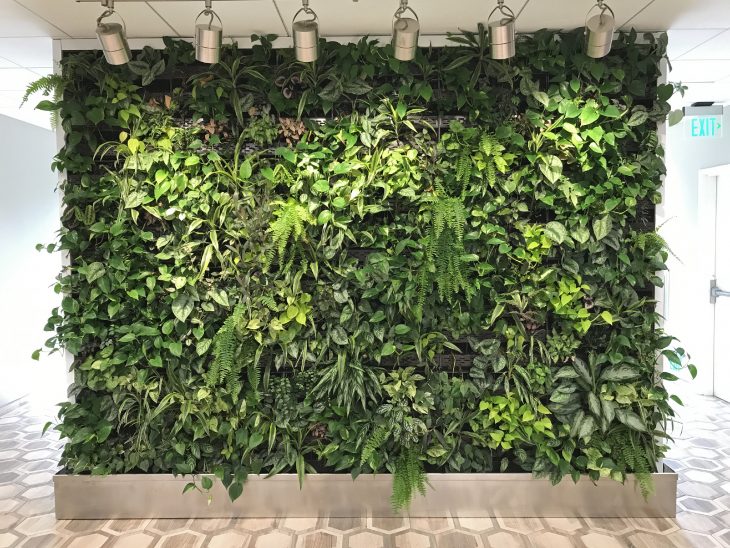A Fresh, Technology-Rich Workplace For A Multigenerational Workforce
by Alexis Ramos
The world headquarters for a Tax Software company in Pennsylvania called on Francis Cauffman Architects (FCA) to create a workspace that was comfortable, collaborative, and distraction free.
Vertex was gearing up for growth after moving from a service company to a consulting enterprise and with the average employee-age being 45 years old, the company wanted to create an environment that supported their 30-year-old and below demographic without alienating their legacy employees. The prevalence of introverts within the company also meant for a need in interactive workstyles that were free of unnecessary stimulus and distraction. Meeting spaces and places to collaborate were also key for Vertex.
Vertex was gearing up for growth after moving from a service company to a consulting enterprise and with the average employee-age being 45 years old, the company wanted to create an environment that supported their 30-year-old and below demographic without alienating their legacy employees. The prevalence of introverts within the company also meant for a need in interactive workstyles that were free of unnecessary stimulus and distraction. Meeting spaces and places to collaborate were also key for Vertex.
When was the project completed?
2017
How much space (SF)?
168,000 RSF (net)
Was this new or renovated space?
A new location and relocation of headquarters. The tenant fit-out is in a leased space.

Square Feet per person?
206 square foot/person on day one and 139 square foot/person by lease end. Infrastructure was built for housing a full growth projection of 1200+ employees.
How many employees?
814 employees
What is the average daily population?
The on-site daily population is approximately 70 percent

Is there a mobile or work from home policy? If so, what percentage of employees are remote workers?
Yes. There is an informal work-from-home policy set by team managers. Occupancy on-site is about 70 percent, which is up 10 percent from previous metrics.
Describe the workspace types.
Open plan, assigned, and universal-sized private offices with glass fronts
What kind of meeting spaces are provided?
- Booths
- Chat rooms
- Enclaves
- Huddle rooms
- Project rooms for long-term team collaboration
- Stadium seating brainstorm rooms
- Two tier brainstorm rooms
- Media share rooms
- Training rooms
- Town Hall audience seating for 380 people
- Patio tables with umbrellas, in range of robust WiFi

What are the project’s location and proximity to public transportation and/or other amenities?
Located in King of Prussia, PA — There are future plans to connect this area with a rail line to center city Philadelphia. This location was chosen because of its proximity to the old location. It was determined that a disruption to a more remote location or to the city would jeopardize their current workforce to leave.
Was the “C” Suite involved in the project planning and design process?
We worked with their long-term space planning committee consisting of the CIO, CFO ( current President), Legal Counsel, Director of Corporate Communications, and Human Resources. This project was unusual since, by coincidence, we had the CEO in nearly every project strategy meeting from beginning to the end of the project.
What kind of programming or visioning activities were used?
There were extensive surveys, visioning and data collections done with this client. They spent a year and a half with their real estate advisors, CRESA, mapping out goals for locations and features that aligned with the company culture. Programming/Visioning activities included:
- Pairwise survey to inform decisions
- Interviews with leadership (spoke with 62 leaders)
- Early financial modeling (to create early financial reality)
- For one more year they worked with FCA to envision the space for fit and feel using image focus groups. This created communication and collaboration models, conceptual model-making, utilization studies, observation studies, “buzz sessions” to inform, and survey employee feedback during critical points of the project.

Were any pre-planning surveys conducted to get employee input?
Yes. Workplace performance, as well as workstyle and collaboration surveys, were conducted.
Was there any other kind of employee engagement activities?
There were “buzz” sessions that took the temperature of the employees’ emotions (indicated with 5 levels of emoticons). During the presentations the employees were asked how they felt about the concept and if it would help them if applied to their work life at the company (indicated with 5 levels of very much to not at all).
Were any change management initiatives employed?
Groups of employees were shown presentations that methodically laid out the reasoning behind the decisions made and backed it up with survey data. After the presentations, there was an open Q&A session. Videos were made and released after employees made a site selection along with a “show where you go” video that highlighted features of the floor plan.

Please describe any program, special research or design requirements that were unique.
The company was sensitive to the possibility of unwanted noise in an open plan environment after previously being in an open plan environment with high panels and little regard to acoustic office treatment.
The new space was constructed with sound masking, double drywall partitions to the deck, and a curvilinear path layout around the main core with a splayed placement of workstation clusters to create a foreshortened view and mitigation of noise.
Was there any emphasis or requirements on programming for health and wellbeing initiatives for employees?
As a group, they were slow to adopt a communal approach and office designed for movement, however, it was important for the company to have access to amenities like a gym facility. Although they don’t have a dedicated gym in their office, large men’s, women’s, and gender-neutral locker rooms and showers were installed to encourage employees to take advantage of the adjacent trails and bike paths.

Were there any special or unusual construction materials or techniques employed in the project?
Designers used a CNC router to create the Vertex feature wall in the reception area. MDF Polyhedrons were sliced and applied in a mosaic style, noting that a sliced polyhedron in geometry is called a vertex figure.
- Shaw’s hexagon (shaped) carpet tile was used to reinforce the faceted theme. It was installed in three colorways to create an ombre effect, increasing in value from the perimeter where it is the lightest to the center core where the flooring was more pronounced and darker. The ‘town center’ amenity core repeated the hexagon shape in a tile called Nouveau Esagona by Nemo Tile. The tile was selected to give the outdoor feeling of cobblestone while accented by outdoor greenery views and an interior live green wall feature.

What product or service solutions are making the biggest impact in your space?
Herman Miller custom-designed workstations and a custom sized pantry have pull-outs that create the suggestion of a third wall in the open workstation. All desk locations in offices, workstations or project rooms have sit-to-stand desks with front screens that rise with the desk to reduce distraction for the user.

What is the most unique feature of the new space?
The variety and number of meeting spaces. The biggest detriment to their productivity was the lack of the right type of meeting space and its ultimate availability. Their old rooms were oversized and lacked the correct AV set up.
Are there any furnishings or spaces specifically included to promote wellness/wellbeing?
Yes. wellness rooms and green wall

What kind of technology products were used?
A robust reservation and kiosk search, ResourceXpress, bezelled on every floor was a dramatic and useful change in the new facility. Vertex wanted an aesthetic that reflected their collegial and people-oriented culture.
If the company relocated to a new space, what was the most difficult aspect of change for the employees?
More open workstations

How did the company communicate about the changes and moves?
Mockup and live samples
Were there post-occupancy surveys? If so, what were the most surprising or illuminating or hoped-for results?
Yes. People came to the office at higher numbers and spent their time being internally mobile, reinforcing the migration to unassigned or shared desks as the company grows.
If a change management project was in place, what were the most successful strategies?
The Buzz sessions gave a comprehensive overview, created an open forum for questions and took the “temperature” of the population along the way for upcoming changes.

Tell us more!
- Architect: Francis Cauffman Architects / LinkedIn
- MEP engineer: Vanderweil
- Contractor: Lakash Construction
- Real Estate Advisors: CRESA
Images courtesy of Francis Cauffman Architects / Kevin Chu
